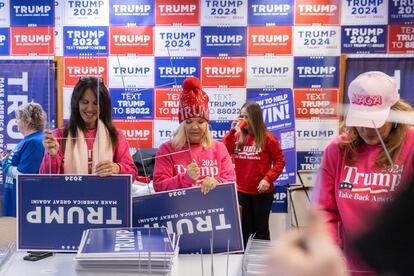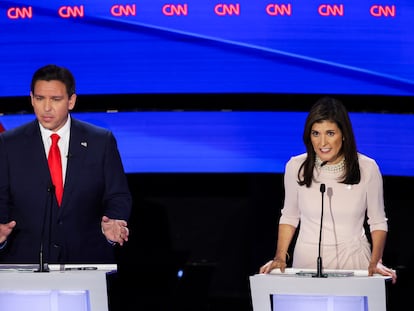Explainer: What are the Iowa caucuses and how do primaries work?
Republicans and Democrats have been introducing changes to their primary process, with the two parties following different rules and calendars

The race to decide who will be running for president at the November 5 election begins on Monday with the Iowa caucuses. Caucus and primary votes are used to elect the delegates who will nominate the presidential and vice-presidential candidates of the two major parties at the summer conventions of the Republican and Democratic parties. On this occasion, there are two very clear favorites: Joe Biden and Donald Trump. But in primaries, there is always room for surprise, especially for the party that is not in the White House. Republican presidential hopefuls Ron DeSantis and Nikki Haley are looking for their chance to make gains, after many of their rivals dropped out of the race.
Historically, even well into the 20th century, candidates for presidential elections were chosen by local and state party leaders, often in closed-door meetings and sometimes in secret. Nominations had little to do with the will of the people. Candidates began to be nominated regularly at party conventions, but the state delegates were not democratically elected representatives until the second half of the 20th century.
When did primaries become popular?
Although some states introduced primaries, the system of election by the party elites was maintained until the 1960 Los Angeles convention. The Democratic Party did not dare to ignore the popular support that John F. Kennedy had won in the primaries. They nominated him to run for president, although they forced him to accept Lyndon B. Johnson as his running mate.
The party machine model continued until the bloody 1968 Democratic National Convention in Chicago, when police clashed with street protesters, including students opposed to the Vietnam War. Democrats created the McGovern-Fraser Commission that reformed the electoral system to give more power to women, minority voters, young people, and citizens in general, to elect their presidential candidate.
Who chooses the presidential candidates?
The two major parties, the Republican Party and the Democrat Party, elect their candidates for president and vice president in specific conventions. That’s where the state delegates cast their vote. These delegates are democratically elected, but the election rules differ slightly between states. The Republican and Democratic primary calendar overlaps in some cases, but in other cases, the votes take place at different times. The two parties also have different rules on delegates.
When are the conventions held?
The Republican convention is scheduled for July 15 to 18, 2024 at the Fiserv Forum in Milwaukee (Wisconsin). An estimated 2,467 delegates will be at the convention. For a candidate to win the nomination, they need 1,238 votes, one vote more than half. The Democratic convention will be held from August 19 to 22 at the United Center in Chicago (Illinois). There will be around 4,540 delegates and superdelegates (which mainly depends on their position) at the convention. But in the first ballot, only around 3,800 delegates votes. If a candidate wins around 1,900 votes in this ballot, they win the nomination. If they do not have a majority, it goes to a second ballot, in which the superdelegates are able to vote. A candidate must win a majority. For now, there is little doubt that the Democrat convention will vote for U.S. President Joe Biden.
What is the difference between caucuses and primaries?
Caucuses are political groups. The word can be used to describe an assembly, board, neighborhood meeting or a faction of parliament, so its meaning varies somewhat depending on the context. In the primary process, there are states that designate their delegates through conventional voting at the polls (primaries), while others do so in meetings or assemblies (caucuses). Caucuses take place in sports centers, civic centers, cafés and even private homes. In the Republican Party, during this cycle, nine states and territories will hold caucuses: Iowa, Nevada, Idaho, Michigan, North Dakota, Utah, Hawaii, Virgin Islands and American Samoa.
Why is the race starting in Iowa?
As part of the reforms that followed the bloody 1968 Democratic convention, Iowa saw that it needed to start with more time to organize its process and decided to get ahead of New Hampshire, which traditionally voted first. When the state saw that this brought it extra attention, it made sure to protect its spot as first on the calendar. The Iowa caucuses kicked off the presidential race for the Democratic Party for the first time in 1972 and for the Republican Party in 1976. The Iowa results served to catapult Jimmy Carter and Barack Obama. A surprise win in the state helps a campaign build momentum and generates media attention. The caucuses also work to narrow down the field of contenders. Many presidential hopefuls realize they have no chance of winning the nomination and withdraw from the race right before or after the Iowa caucuses.
How do the Iowa caucuses work?
The Republican caucuses — which are the ones that are of interest this year, because there is little doubt Biden will win the Democrat nomination — are actually very similar to conventional primaries. Registered voters who wish to vote will gather in community centers, sports centers, various venues and even private homes at 7 p.m. and cast their ballot. The votes are then counted. Sometimes there are speeches and debates, although this is not necessarily the case. Until 2020, the Iowa Democratic Party held in-person caucuses. But this year, the party has opted for mail-in ballots, with voting open until March. Biden believes that the race should begin in a more diverse state, and has pushed for it to be South Carolina. New Hampshire, however, is fighting to keep its spot on the calendar.
How many delegates are elected in each state?
In the case of the Republican Party, a candidate needs to win 1,234 of the 2,467 delegates to secure the nomination. In Iowa, 40 delegates are elected. These are awarded proportionally based on the votes in the state as a whole. The states with the most delegates are California (169), Texas (162), Florida (125) and New York (91), the four most populated states in the country.
How are delegates awarded?
In caucuses and primaries held through March 15, delegates are awarded in proportion to their share of the statewide vote or the vote in each district. Many states require that candidates meet a certain vote threshold at either the statewide or district level to qualify for any delegates. This figure ranges from 4% to 20%. The vast majority — 1,920 delegates in 41 races — operate in this way using a mix of proportional and winner-takes-all methods. New York, for example, has a 20% threshold for the proportional allocation method, but if a candidate gets a majority, they get all the delegates. States and territories follow different rules. In some cases, the delegates are not bound, and can vote for anyone at the convention.
Where are the next primaries?
The Republican primary race continues in New Hampshire on Tuesday, January 23, when 22 delegates are up for grabs. It is followed by Nevada on February 8, where 26 delegates will be chosen in caucuses, and then South Carolina (50 delegates on February 24). Michigan will hold both primaries (February 27) and caucuses (March 3) to elect its 55 delegates. And Super Tuesday will take place on March 5, when 874 delegates are elected in 16 states, including California (169), Texas (162), North Carolina (75) and Tennessee (58). The day before Super Tuesday, Trump is scheduled to stand trial, although he is trying to push back the date. By Super Tuesday, more than 40% of the delegates will have been awarded. The presidential nomination is likely to be decided in March, before Trump’s criminal trial in New York.
Who is the favorite in the polls?
Biden is the undisputed favorite in the Democratic primaries, as is often the case with the sitting president. On the Republican side, among voters throughout the United States, Donald Trump also has an enormous lead. He is polling at 60.4%, while DeSantis is on 12.1%; Haley is on 11.7% and Vivek Ramaswamy is on 4.3%, according to the FiveThirtyEight polling average. In Iowa, Trump’s advantage is smaller, but notable : 51.3%, compared to Haley’s 17.3%; 16.1% for DeSantis and 6.6% for Ramaswamy.
Has any other candidate run after leaving office?
Trump is the first president to run after leaving office since Herbert Hoover tried unsuccessfully in 1940. If he wins the Republican nomination, he will be the first Republican to be nominated president three separate times since Richard Nixon (nominated in 1960, 1968 and 1972), and the first person to be the Republican presidential nominee in three consecutive elections. If he was nominated and won, he would be the first president to serve non-consecutive terms since Grover Cleveland, who won his second term in 1892.
Sign up for our weekly newsletter to get more English-language news coverage from EL PAÍS USA Edition
Tu suscripción se está usando en otro dispositivo
¿Quieres añadir otro usuario a tu suscripción?
Si continúas leyendo en este dispositivo, no se podrá leer en el otro.
FlechaTu suscripción se está usando en otro dispositivo y solo puedes acceder a EL PAÍS desde un dispositivo a la vez.
Si quieres compartir tu cuenta, cambia tu suscripción a la modalidad Premium, así podrás añadir otro usuario. Cada uno accederá con su propia cuenta de email, lo que os permitirá personalizar vuestra experiencia en EL PAÍS.
¿Tienes una suscripción de empresa? Accede aquí para contratar más cuentas.
En el caso de no saber quién está usando tu cuenta, te recomendamos cambiar tu contraseña aquí.
Si decides continuar compartiendo tu cuenta, este mensaje se mostrará en tu dispositivo y en el de la otra persona que está usando tu cuenta de forma indefinida, afectando a tu experiencia de lectura. Puedes consultar aquí los términos y condiciones de la suscripción digital.
More information
Archived In
Últimas noticias
NASA discovers Titan doesn’t have an ocean, but a ‘slushy ice layer’ that increases possibility of life
Innocence lost in the forest of the child soldiers: ‘Each leader of the armed group had his girls’
‘Fallout’ or how the world’s largest company turned an anti-capitalist apocalyptic Western into a phenomenon
From inflation to defending migrants: Eileen Higgins and Zohran Mamdani inaugurate the new Democratic resistance against Trump
Most viewed
- ‘El Limones’ and the growing union disguise of Mexican organized crime
- Christian Louboutin: ‘Young people don’t want to be like their parents. And if their parents wear sneakers, they’re going to look for something else’
- The low-cost creative revolution: How technology is making art accessible to everyone
- ‘We are dying’: Cuba sinks into a health crisis amid medicine shortages and misdiagnosis
- Liset Menéndez de la Prida, neuroscientist: ‘It’s not normal to constantly seek pleasure; it’s important to be bored, to be calm’










































